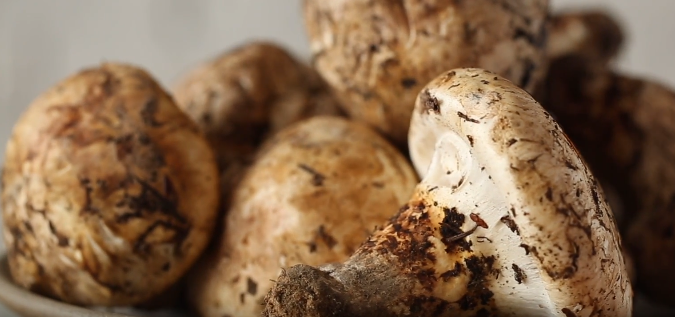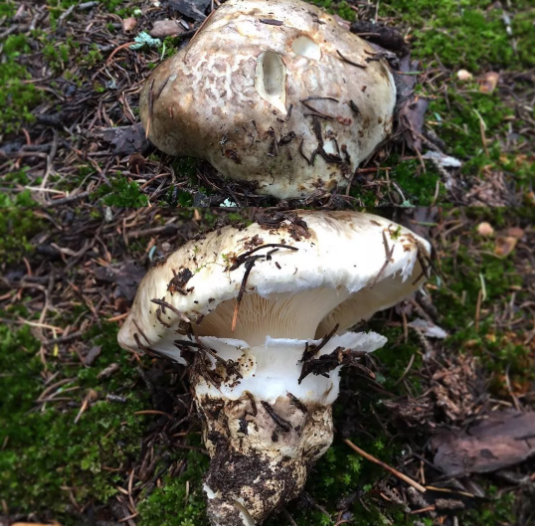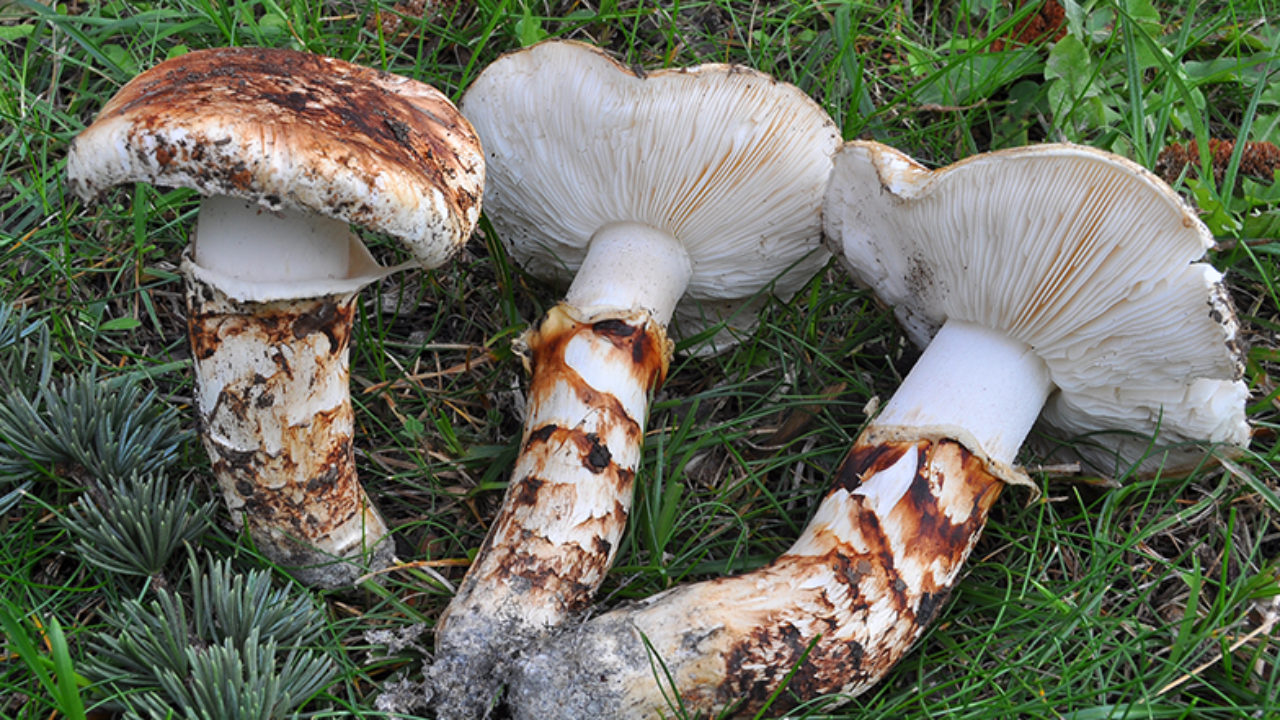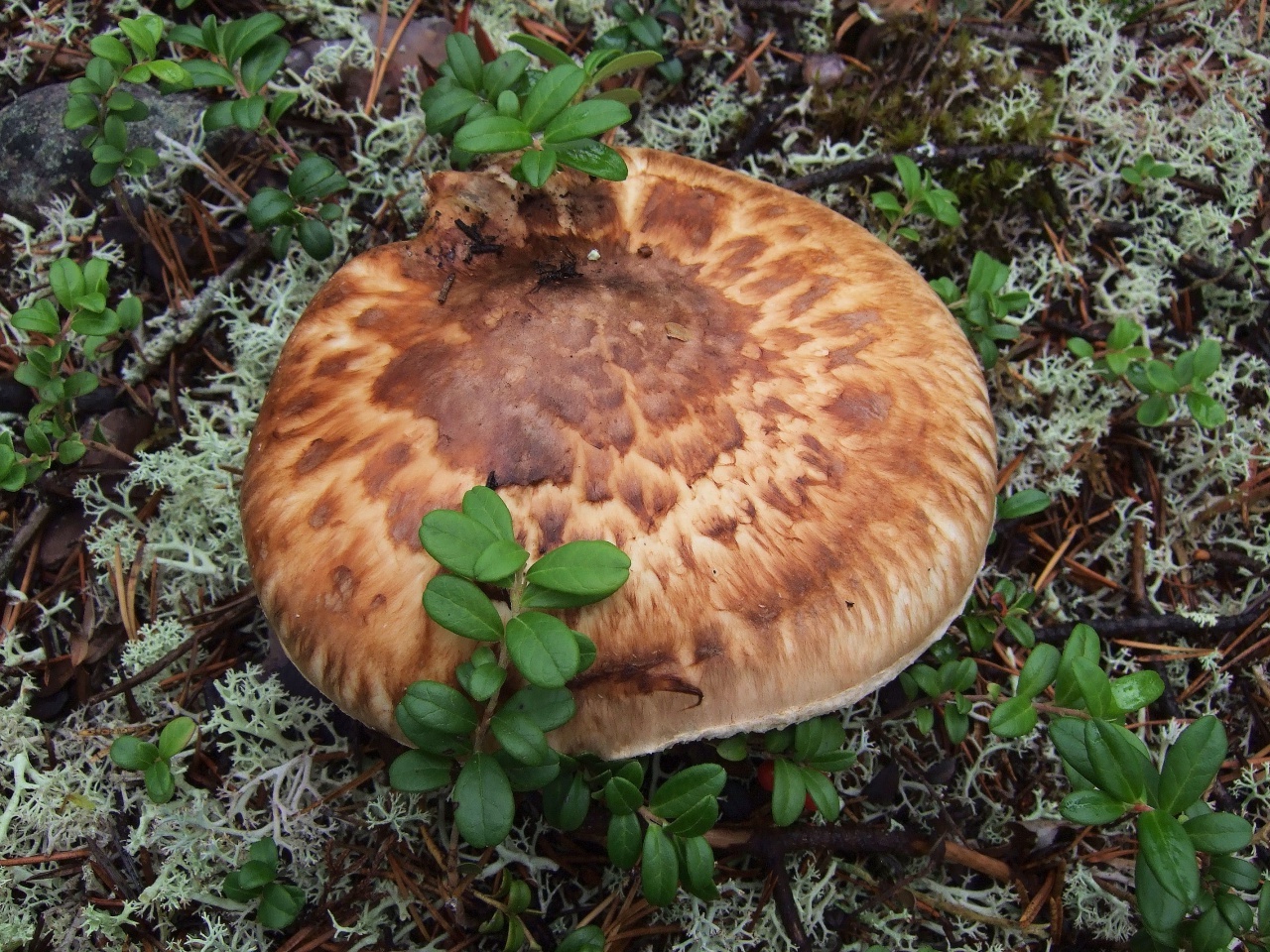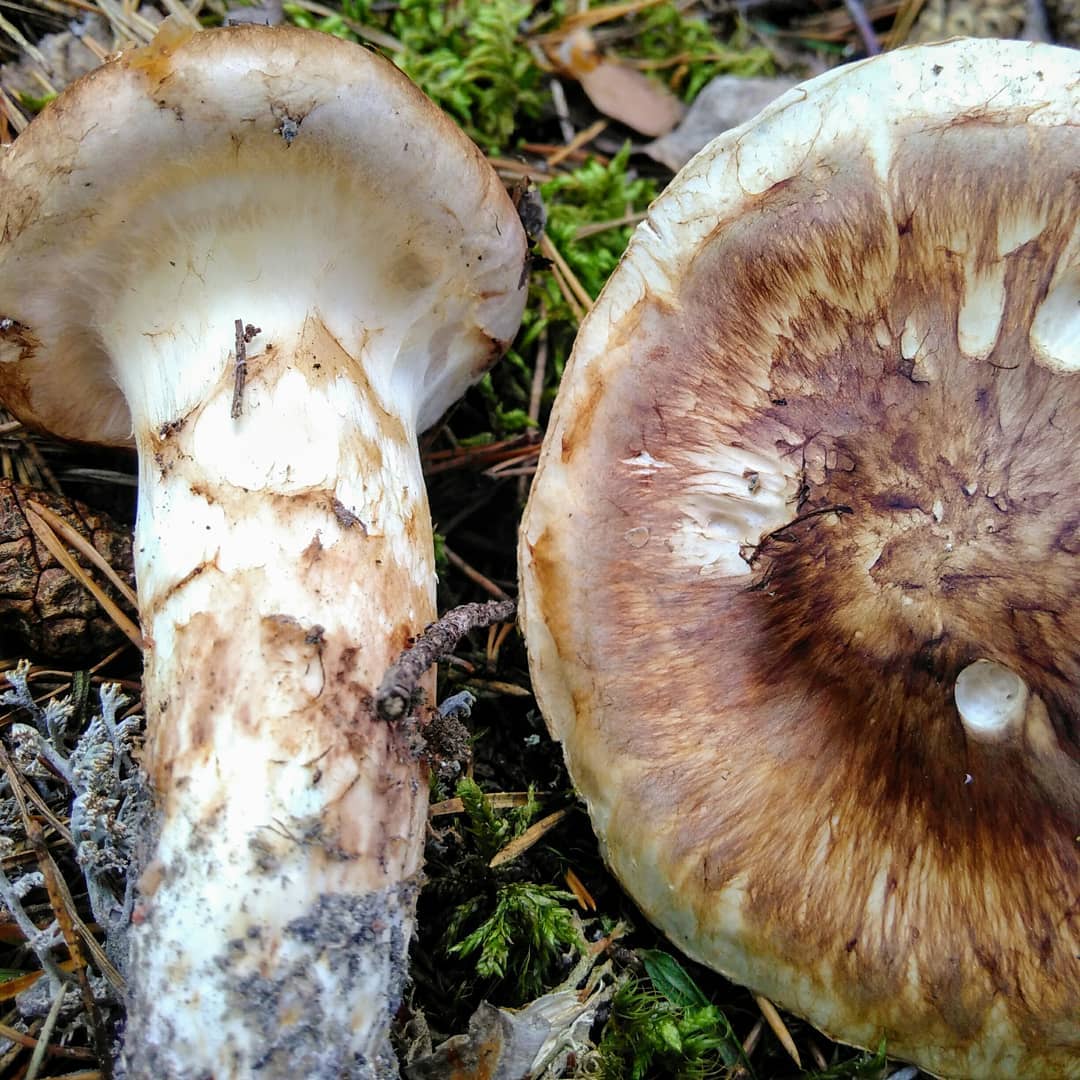Description
Matsutake is a name translated from Japanese as "pine mushroom", since usually this ryadovka carries out mycorrhiza formation with pine.
Hat
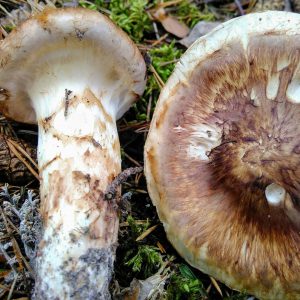
The hat is medium-sized, brown. The color of the cap is uneven, its surface is dry and smooth, in mature specimens it cracks and the flesh is visible through the cracks.
Leg
The leg of matsutake can reach considerable length (up to 25 cm), in thickness - about 3 cm. The leg is usually very deeply rooted in the ground, so getting this mushroom "by the root" is not an easy task.
The color of the leg is brownish-white, its surface is completely covered with brownish scaly growths. In the upper part of the leg, there is an annular outgrowth from the torn bedspread. This outgrowth is uneven, fragmentary, brown in color. Above it, the leg is covered with a coating that looks like flour.
 Spore-bearing layer
Spore-bearing layer
The matsutake hymenophore is lamellar. In most specimens, the hymenophore is covered with fragmentary remains of velum. The plates are white or slightly yellowish; with mechanical damage, they change color to brown.
Pulp
The flesh of the matsutake is white and thick. Emits a pleasant aroma, at the same time similar to pear, cinnamon and pine needles. The mushroom tastes pleasant with a bitter aftertaste.
Habitat and fruiting period
The Matsutake mushroom, whose name is translated from Japanese as a pine mushroom, grows mainly in Asia, China and Japan, North America and Northern Europe. It grows near the foot of trees, often hiding under fallen leaves. A characteristic feature of the matsutake mushroom is its symbiosis with the roots of powerful trees growing in certain areas. For example, in North America the mushroom is symbiotic with pine or fir, and in Japan - with red pine. Prefers to grow on infertile and dry soil, forms annular colonies. Interestingly, as this type of mushroom matures, the soil under the mycelium turns white for some reason. If suddenly the soil fertility increases, such an environment becomes unsuitable for further growth of Matsutake (Tricholoma matsutake). This usually happens when the number of falling branches and old leaves increases.
Fruiting matsutake begins in September and continues until October. On the territory of the Russian Federation, this type of fungus is widespread in the Southern Urals, the Urals, the Far East and Primorye, Eastern and Southern Siberia.
Matsutake (Tricholoma matsutake) is a mycorrhizal forming agent of oak and pine, found in oak-pine and just pine forests. Fruiting bodies of the fungus are found only in groups.
Useful properties and contraindications
As such, "pine mushroom" has no contraindications to use. The only problem may be individual sensitivity to the substances that make up its composition. In addition, you should not cook harvested mushrooms that have been stored for too long.
Matsutake, precious and healing VIPs of the mushroom world, grow not only in the Japanese islands. Perhaps, in warm and humid autumn, in the pine forests of the middle zone, this mushroom, growing in secretive but numerous groups, will give its incomparable aroma to successful domestic pickers.
Sources of information:
Similar species, distinctive features from them
In 1999, scientists from Sweden, Danell and Bergius, conducted a study that made it possible to accurately determine that the Swedish mushroom Tricholoma nauseosum, previously considered just a similar species to the Japanese matsutake, is in fact the same species of mushroom. The official results of the comparative DNA allowed a significant increase in the number of exports of this variety of mushrooms from Scandinavia to Japan.And the main reason for such a demand for the product was its delicious taste and pleasant mushroom aroma.
Mushroom photo Matsutake from questions in recognition:
What are Enoki mushrooms?
Enoki mushrooms (Flammulina veluptipes) also known as winter honeydew mushrooms or even Enokidake mushrooms are actually a long and thin type of mushroom with small caps on one end. These mushrooms are native to China, Japan and Korea.
There are many types of enoki mushrooms. They are grown all over the world, the most famous are off-white, light brown, and also golden-colored mushrooms. The white variety is usually sold in supermarkets and is often grown in bottles, so there is a kind of bottled impression in the bottom of the mushroom in the form of a clot.
The wild variety is light brown in color and also gold in color with a thicker stem. These mushrooms are mainly used in soups, Asian delicacies, as well as salads and stir-fries.
Enoki's mild flavor absorbs the flavor of any other ingredients used with it. Enoki is better to buy fresh, straight from the bottle
When choosing fresh mushrooms, it is very important to find a clean texture and excellent caps without the slightest hint of slimy
Mucus indicates that the mushrooms are expired and should not be used.
Comparing these famous Asian mushrooms with others, their expected shelf life even in the refrigerator is not long, so it is very important to use them soon after purchase.
Throughout Asian history, doctors have considered enoki mushrooms to be more beneficial than other Asian mushrooms, as beneficial properties include general immune system boosting properties, anti-cancer properties, treatment of liver and stomach problems, high cholesterol and blood pressure, and anti-aging properties.
Enoki are often used in Asian herbal medicines and tonics for cancer patients in addition to general chemical medicines. Its low calorie content and high nutritional value make it possible to include yenoki in your daily meal in Asia.
Cooking use
In cooking, ryadovka shod is prized primarily for its extraordinary aroma and taste, for this reason many dishes are made from this delicacy: soup is prepared, grilled or grilled, stewed, pickled, dried. Gourmets prefer to eat them raw.
Before cooking, you need to prepare the mushrooms so as not to get poisoned and at the same time preserve the unique notes in the taste.
To do this, it will be enough to gently rinse them with running water or wipe them with a dampened cloth.
When cooking, you need to consider the following points:
- Only the hardest part of the leg is removed - the lower one (1-2 cm).
- With strong heat treatment, as well as with drying or freezing, matsutake lose their taste and aroma. They cannot be overcooked or overheated.
Types of matsutake mushrooms, appearance
Matsutake mushroom (Tricholoma matsutake) belongs to the Ryadovok genus (Tricholoma), the Ryadovkovy family. Also in Russia, the common people use the name "shod ryadovka". Matsutake in translation from Japanese means pine mushroom, this name was given to him for an interesting pine smell and an amazing taste, unlike any other mushrooms. Edible matsutake mushrooms, see the photo in the gallery below, grow both in nature and are grown artificially, for which the mycelium (mycelium) is used. Industrial cultivation of mushrooms is very difficult and rarely gives good results. Visually, mushrooms are similar to honey mushrooms, however, they have a wider cap and a stocky leg.
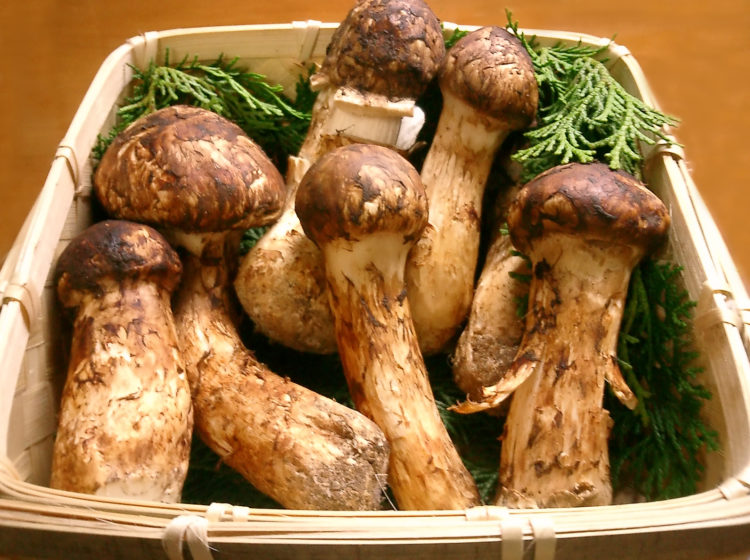
- Tricholoma matsutake has a brown cap (different shades are possible) with a diameter of 6-18 cm, covered with dark brown silky scales. The leg of the row grows vertically or horizontally, slightly widened near the ground, has a diameter of up to 2.5 cm and a length of up to 20 cm, there is a fringed ring on the leg, the color of the leg above the ring is usually lighter than below. The plates are light in color, frequent, narrow. The pulp is white, dense, pleasantly smelling of pine needles.The species grows in Japan, Asia, on the territory of Russia, in North America. The most delicious is the mushroom from the Amur Territory and Primorye.
- Tricholoma nauseosum (cingulatum) - a close relative of the above described species, grows in the north of Sweden and Finland in coniferous forests, on sandy soils. It has a lighter color of the cap and a less pronounced odor; it is quite rare in the nature of Scandinavia.
Where to find matsutake mushrooms?
These mushrooms grow in pine and oak-pine forests. They form mycorrhiza with conifers, rarely grow next to oak trees. Matsutake prefer old groves in which the age of trees is 20-60 years. In Korea and Japan, matsutake grows under red pine trees, and in North America under pine and fir trees.
As a rule, shod rows grow in large "witch rings" around the trees.

At the same time, the mushrooms deftly hide under the leaves. Matsutake prefer to grow on infertile soil, and when the number of fallen leaves increases and soil nutrition improves, then such an environment for fungi becomes unsuitable. In this regard, the colony does not bear fruit in one place for more than 10 years.
Matsutake are quite picky mushrooms that need certain weather conditions to grow - the temperature during the day should not rise above 26 degrees, and at night - drop below 15 degrees. When the precipitation increases by about 100 millimeters in 20 days, only in this case the shod rows begin to grow. Therefore, these mushrooms can be found on sale only for about 20 days in September-October. Occasionally, under favorable conditions, matsutake can be found in August. In Korea, August mushrooms are called "summer dormouse", but they are less aromatic and tasty than mushrooms that grew in season.

Usefulness of shod rowing
Fresh mushrooms are high in vitamins, proteins and amino acids. Shod rows have antiviral properties. They also have anti-cancer effects. Eating matsutake can help lower blood pressure. In addition, they are characterized by antihypoxic, antidiabetic and sedative effects.
The use of these mushrooms is also shown for problems with joints, diseases of the genitourinary organs, stomach ulcers, arteriosclerosis, infertility, bedsores and wounds. Matsutake treatment has been proven to have no side effects.

In addition, ryadovka brown is an excellent cosmetic product - the extract of this mushroom brightens the skin, removes pigmentation and improves the appearance of the skin.
Useful and medicinal properties
The complex compounds that make up the matsutake mushrooms have antiviral and anticancer effects, confirmed by laboratory tests. In addition, they lower blood pressure, normalize blood sugar levels and have no side effects.
In traditional Chinese medicine, these mushrooms are considered a good remedy for diseases of the gastrointestinal tract, a sedative and pain reliever.
Matsutake extract is also used in cosmetology as a skin lightening agent and improving its condition.
The value of matsutake is as follows:
- Strengthening the immune system due to its chemical composition.
- Helps to get rid of carcinogens and radionuclides, destroying the body.
- Prevention of diabetes. Normalizes blood sugar levels in diabetics.
- Anticancer agent. In case of leukemia, Chinese healers advise to consume it in its raw form within 2 days after picking the mushroom. For the greatest effect in treatment, it must be consumed raw.
- With a diet. The low fat content helps control body weight.
In addition, Japanese truffle is an excellent cosmetic product. Extracting this mushroom removes pigmentation, brightens the skin and improves the appearance of the skin.

Abuse of shod rowing shoes can threaten:
- Diseases of the gastrointestinal tract.With pancreatitis and dysfunction of the gallbladder, it is not recommended to use matsutake at all, and in other cases, there may be cramps and heaviness in the stomach, flatulence.
- Poisoning. This mushroom cannot be stored for a long time, and it also absorbs harmful substances, which makes it even dangerous to health.
- Intolerance. For people with an allergic reaction to mushrooms, in no case should you take risks and use this product.
In case of poisoning, the following symptoms are observed:
- Profuse salivation. Often appears during hunger, but in case of intoxication, food will not help stop it.
- Diarrhea. An upset stomach is always present when the body does not accept a product. This case is no exception.
- Nausea. Severe poisoning ends with vomiting, which, in some cases, cannot be stopped even by pharmaceutical drugs.
At the first sign of poisoning, it is imperative to consult a doctor.
In cooking
As for the gastronomic direction, it is believed that the shod ryadovka is best consumed raw. It is the fresh mushroom that is able to leave a long aftertaste of fruit and aromatic cinnamon. The delicacy is added to all kinds of salads, soups, pastas, meat dishes
If the fruit body needs to be processed at high temperatures, it is important to do this very quickly, otherwise the delicacy will lose its taste.

Gourmets recommend buying only young specimens of culture, they can be recognized by their neat, not fully opened hats. Before use, be sure to check whether you got a fresh copy.
We've looked at the benefits and features of the Matsutake delicacy. If you still haven't had time to enjoy the taste of the forest masterpiece, hurry up to correct this misunderstanding.
Taste qualities of matsutake
The shod ryadovka is a delicacy mushroom, which has excellent taste. These mushrooms are used for food only fresh.
The flesh of matsutake is firm with good taste and aroma. This mushroom combines the smell of pear, cinnamon and the bitter taste of pine resin. For these qualities, the mushroom is highly valued among culinary experts. If you eat matsutake, you will have an amazing pine aroma in your mouth all day long.

An unusual feature of this mushroom is that its flesh, although firm, chews well. These mushrooms are not easy very tasty, but they go well with different foods. Pieces of matsutake can be added to salads, thrown into hodgepodge and soups at the end of cooking, grilled a little and served with meat.
In Japan, these rows are valued as highly as truffles in Europe. Young specimens with long legs and small unopened caps are considered the most delicious. The best taste in this mushroom is its slippery skin, which remains crispy.

Before using the mushroom, you do not need to rinse it too much, it is rinsed or wiped with a damp towel. The bottom of the leg is removed as it is hard. When peeling, the peel is left, because it is the most valuable in the mushroom.
You need to be able to properly prepare matsutake, because when cooked, frozen or dried, they lose their delicate taste and aroma of needles. Fried matsutake is a rather expensive delicacy.
Useful properties and contraindications
The value of matsutake is as follows:
- Strengthening the immune system due to its chemical composition.
- Helps to get rid of carcinogens and radionuclides, destroying the body.
- Prevention of diabetes. Normalizes blood sugar levels in diabetics.
- Anticancer agent. In case of leukemia, Chinese healers advise to consume it in its raw form within 2 days after picking the mushroom. For the greatest effect in treatment, it must be consumed raw.
- With a diet. The low fat content helps control body weight.
In addition, Japanese truffle is an excellent cosmetic product. Extracting this mushroom removes pigmentation, brightens the skin and improves the appearance of the skin.
Abuse of shod rowing shoes can threaten:
- Diseases of the gastrointestinal tract. With pancreatitis and dysfunction of the gallbladder, it is not recommended to use matsutake at all, and in other cases, there may be cramps and heaviness in the stomach, flatulence.
- Poisoning. This mushroom cannot be stored for a long time, and it also absorbs harmful substances, which makes it even dangerous to health.
- Intolerance. For people with an allergic reaction to mushrooms, in no case should you take risks and use this product.
In case of poisoning, the following symptoms are observed:
- Profuse salivation. Often appears during hunger, but in case of intoxication, food will not help stop it.
- Diarrhea. An upset stomach is always present when the body does not accept a product. This case is no exception.
- Nausea. Severe poisoning ends with vomiting, which, in some cases, cannot be stopped even by pharmaceutical drugs.
At the first sign of poisoning, it is imperative to consult a doctor.
Spread and harvest season
Translated from Japanese "matsutake" - "pine mushroom". Indeed, this highly prized delicacy grows under the pines, sometimes in oak and broadleaf forests mixed with pines. On the Japanese islands, it has become a rarity, so that the needs of local lovers of gourmet mushroom cuisine are partly satisfied by imports. Pine mushroom is harvested in Korea, China, North America, Sweden and Finland. They find it in the Southern Urals, in the Siberian, Far Eastern, as well as in the Belarusian and Ukrainian forests.
A mushroom that grows in groups, often forming rings around pines, is difficult to find because its cap, crowning a deep-seated leg, barely peeps out from under a layer of foliage and needles. In addition, matsutake is picky about temperature and humidity conditions and soil fertility. For a guaranteed yield of this mushroom, the following combination of factors is required:
- the daytime temperature is not higher than 26 ºC, and the nighttime temperature is not lower than 15 ºC;
- the amount of precipitation for 20 days - 100 mm and more;
- well-drained soil without excess nutrients. If the fallen leaves produce more humus, the fruiting bodies do not develop.

The harvesting season with such conditions falls on September-October and lasts no longer than 20 days. It was at this time that Japanese matsutake pickers set out on mushroom hunting. North American, Korean, Chinese, Finnish and Swedish miners are not lagging behind them, because the prompt export of carefully packed "pine mushroom" to Japan is a well-paid business.
Similar types and differences from them
Matsutake is somewhat similar to a row of grass-shaped or bandaged (Tricholoma focale) - a little-known edible mushroom. It also grows near pine trees, has a fibrous-scaly cap of variegated brown tones, a fibrous ring on the leg and a fleshy light flesh. However, unlike the “pine mushroom”, this row has a very short stem, easily removed from the soil, and a distinct mealy smell.
Growing among Scandinavian pines, the Tricholoma nauseosum row has been found to be the same species as the famous matsutake. It was after this confirmation that the Swedes and Finns began to collect the "pine mushroom" for export.
Where it grows in Russia
How can we find and recognize the forest gift to our compatriots, because above we managed to find out that the delicacy also grows in the forests of our country?
Focus on the crop's natural growing season. In order for the mushroom mycelium to begin to bear fruit, certain conditions are necessary: high humidity, heavy rainfall, the air temperature not higher than 25 and not lower than 16 degrees Celsius. As a rule, a similar climate is characteristic of the first autumn months (September, October). It grows in Russia in the wild places of Primorsky Krai, the Urals, Khabarovsk, Priamurye.

Going on a "quiet hunt", look for mushrooms according to the following description:
- The color of the fruiting body ranges from brown to brown, sometimes it is confused with the boletus, since the external resemblance cannot be called weak.
- The diameter of the cap of the average representative is 7-18 centimeters, the skin is dry, covered with small, fibrous scales. The inner side is covered with light-colored plates.
- The leg is fleshy, rather thick, stable, up to 18 cm high.
- The spores are very small and dark.
The older the specimen, the more its cap opens, becoming almost flat over time.

Matsutake has a specific aroma that is not inherent in any other mushroom - it smells like pine needles and cinnamon. Fungi develop in groups, literally "ringing" the pines. If you come across a similar mushroom under a deciduous tree, it's not Matsutake.
Evaluation of taste, benefits and possible harm
Due to its exquisite taste, aroma and its nutritional value, pine ryadovki are widely used in the cooking of many countries, especially Eastern ones. Their slippery legs have a pleasant crunchy texture and are the most “mouth-watering” part. In matsutaka, bitterness is completely absent.
The most common cooking method is roasting over hot coals. Citrus sauce is used as a seasoning. Alternatively, the fruits are processed using a steam grill, wrapped in foil and poured over with sake. Soup is also cooked, stewed, cooked with chicken and rice or in a pot with fish, added to salad. Matsutake can be salted, pickled, but it is impractical to do this for economic reasons.
Initial processing and cleaning
Before cooking, it is enough to lightly rinse the raw material under water, wipe it with a clean cloth. The legs of the spotted row are not cut off, unlike other mushrooms, they only remove their hard part (a couple of centimeters from the root). Then the fruits are broken by hand into pieces or cut into slices.
When preparing matsutake dishes, it is highly advisable not to overcook, as this decreases their wonderful delicate aroma and decreases the amount of nutrients. Sometimes the fruits are even eaten raw - then all the advantages of the product are preserved as much as possible.
Dishes with matsutake
Grilled “royal” mushroom is a rather expensive pleasure. Therefore, the most widespread are dishes using it as an additive or side dish. The base is impregnated with a mushroom smell, forming a new, exotic one, and the taste is enriched with additional shades.
Matsutake Gohan Recipe
Ingredients:
- Japanese truffle - 100 g;
- rice - 2 cups;
- dashi (fish broth) - 300 ml;
- deep-fried tofu cheese - 100 g;
- soy sauce - 2 tbsp. l .;
- sake - 2 tsp
Cooking process:
- Rice should be rinsed several times in cold water, it should become transparent. Then let it drain.
- Put the dashi broth and rice in a rice cooker, leave for half an hour.
- Cut the pine horns into strips.
- Cut the fried tofu into thin strips.
- Put mushrooms, cheese, sake and sauce in a rice cooker, put on the cooking mode.
- Bring to readiness.
Matsutake dobin mushi
Components:
- pine row - 1 pc .;
- chicken thighs - 8 small pieces;
- dashi broth - 3 cups;
- lime - 4 slices;
- peeled shrimps - 4 pcs.;
- salt - 15 ml;
- soy sauce - 15 ml;
- sake - 40 ml.
Cooking:
- Slice the mushrooms longitudinally.
- Pour sake, sauce, dashi broth into a saucepan and bring to a boil. Salt.
- Divide the shrimp and chicken thighs into pieces, put in teapots. Pour over the soup.
- Keep on a steam bath for about 15 minutes.
- Pour the dish into cups, add the lime slices.
Salting
Pine horns processed in this way are crispy and very dense, retain their aroma and all the beneficial substances. Can be used for cooking in winter.
For this you need to take:
- matsutake - 0.5 kg;
- salt - 3 - 4 tsp;
- vinegar - 1 tsp;
- spices (black pepper, bay leaf, garlic) - to taste.
Salting process:
- The legs are separated from the caps, cut into 3-4 parts.
- Fruits are placed in sterilized jars with their caps down.The gaps are filled with parts of the legs.
- Sprinkle the layer with salt and spices.
- Then you need to lay the next layer of mushrooms, also falling asleep with seasonings and salt. Repeat phases.
- The last layer is covered with spices. Put oppression on top.
The product will be ready in 1.5 months.
Spread of Matsutake mushrooms
The Japanese mushroom grows not only in Japan, but also in other parts of the world. Due to the massive collection of shod shoes, its number in the Japanese islands has significantly decreased, so local businessmen import this product from Europe, North America, Russia and other Asian countries. Matsutake is grown in Sweden, Finland, China and Korea. On the territory of Russia, pine mushrooms are found in Sakhalin, Siberia and some areas with light sandy soils and pine forests.
This species grows massively in the northwestern forests of the United States. The Americans have built a lucrative business exporting it to Japan. About 20 years ago, they began to actively collect Japanese mushrooms and sell them abroad at a cost of $ 200 per kg. Soon the Canadians began to engage in the same activity. In the 1980s, the Chinese collected matsutake in Shanghai and exported them to Japan or Western Europe, mistaking them for common toadstools, not worthy of attention.
Harvest time

It is important to harvest on time
Matsutake are very demanding on growing conditions. During the day, the temperature should not rise above + 26 ℃, and at night it should not drop below + 15 ℃; the amount of precipitation during the month must be more than 100 mm. To get a rich and high-quality harvest of these mushrooms, the soil must be, no matter how strange it may seem, infertile, but well-drained, which means it must be dry. An increase in the amount of nutrients in the soil leads to poor growth of fungi. For your information. Near the mushrooms, the soil turns white, i.e. almost all nutrients are removed from it. For more than 10 years, the colony in one place "does not sit up".
If the right conditions are maintained, the crop will ripen by September or October. The collection takes about 20 days. If matsutake is not collected in time, they will start to deteriorate and lose their useful properties, which significantly reduce their value and cost.
In cooking
As for the gastronomic direction, it is believed that the shod ryadovka is best consumed raw. It is the fresh mushroom that is able to leave a long aftertaste of fruit and aromatic cinnamon. The delicacy is added to all kinds of salads, soups, pastas, meat dishes
If the fruit body needs to be processed at high temperatures, it is important to do this very quickly, otherwise the delicacy will lose its taste.
Gourmets recommend buying only young specimens of culture, they can be recognized by their neat, not fully opened hats. Before use, be sure to check whether you got a fresh copy.
We've looked at the benefits and features of the Matsutake delicacy. If you still haven't had time to enjoy the taste of the forest masterpiece, hurry up to correct this misunderstanding.
127Rating article
Matsutake, or Matsutaki, is an edible gourmet mushroom of the Tricholoma genus. Mostly they grow in the countries of Asia, Northern Europe, America and in some regions of Russia. This species is of particular value in cooking. Let's consider its medicinal properties and gastronomic qualities.
Matsutake mushroom - description of the species, habitat and time of collection
Botanical description

The head of the Japanese truffle is dry, rounded-convex with rolled edges from 3 to 20 cm in diameter. In mature mushrooms, it is flat with a wide tubercle in the center. In a young fruiting body, it is smooth, then with adjoining fibrous scales, fibers and residual veil are noticeable along its edge. Light brown and nut-brown colors.
In ripe fruits, the surface of the cap is cracked and white flesh is visible. It is dense with a scent that combines aromas of fruit, pine resin and cinnamon.
The plates are uneven, white or light cream.In young mushrooms with a small cap, they are completely hidden by a light blanket.
The leg is clavate, about 3 cm in diameter, and 20 cm long. It can expand towards the base or, conversely, narrow. Off-white in color with a brown, fringed, irregular ring. The lower part of the leg is covered with nut-colored fibrous scales, and a powdery coating is noticeable above the ring. The leg is very deeply buried in the soil.
The spores are round, small, brown.
Edibility
Matsutake is edible and can be consumed and stored in any form: raw, boiled, frozen, stewed, fried, pickled, salted. It can also be dried. These mushrooms are delicious and go well with other foods. It can be added to soups and hodgepodge, salads, served with meat and grilled. The slippery skin on the cap of young fruit bodies remains crispy.
Application

In cooking
Delicacies from the shoddy ryadovka have the aroma of pine and pear and are very much appreciated by gourmets. In most cases, matsutake is not served as a separate dish, but in addition to soups, salads, snacks and side dishes. Often, mushrooms are not subjected to heat treatment, simply by cutting them into transparent plates so that their unusual aroma is more vividly manifested.
Connoisseurs divide mushrooms into categories according to smell and taste. Elite rowers are usually supplied from the Russian Primorye. Young, unblown mushrooms are valued more. Only fresh matsutake is used; in dried or frozen form, they lose their unique smell, original taste.
In medicine
All the useful, medicinal properties of mushrooms are used in medicine in Japan, from mushroom powder they make drugs that help fight influenza viruses, prepare tinctures that lower blood pressure, regulate the functioning of the stomach and intestinal tract, help with diabetes (lower sugar content). Medicines from mushrooms are used in the complex treatment of cancer. Matsutake are part of the mushhima mushroom extract (strengthening the immune system).
Where, when and how it grows
The exquisite matsutake ryadovka is the most expensive mushroom in the world today; it will naturally melt on the islands of Japan, Primorye, Khabarovsk Territory, Sakhalin, the Urals, northern Europe, Asia (China, Korea), Sweden and Finland, on the North American continent (USA, Canada). For growth, the matsutake mushroom chooses dry, sandy loam, well-drained, not too fertile soils at the roots of trees. Thus, the Japanese forest mushroom grows mainly in the roots of red pine, hiding in fallen needles. When the layer of needles and leaves grows large and fertilizes the soil, the matsutake leave the area.

The shod row grows, forming a symbiosis with some types of conifers: with Japanese red pine, North American pine, fir. Also inhabits other coniferous trees, sometimes found at the foot of oak trees, always prefers old coniferous massifs, where the age of trees exceeds 20 years (and more). Fruiting bodies form ring-shaped groups. In most cases, the duration of growth of fungi in one area of the forest does not exceed ten years.
Matsutake are very demanding on weather conditions, the temperature during the day for their normal growth should not be higher than 26 ° C, at night it should not fall below 15 ° C, the monthly precipitation rate should not exceed 100 mm. Mushrooms are harvested from September to October, the duration of fruiting is usually 15-20 days.
Matsutake
External description of the mushroom
Matsutake (Tricholoma matsutake) has a fruiting body with a cap and a leg. Its flesh is white in color, characterized by a pleasant spicy aroma, similar to the smell of cinnamon. The hat has a brown color, and in ripe and overripe mushrooms, its surface cracks and white mushroom pulp is visible through these cracks. In its diameter, the cap of this mushroom is quite large, has a rounded-convex shape, a tubercle of large width is clearly visible on it. The surface of the cap is dry, initially off-white or brownish, smooth.Later, fibrous-type scales appear on it. The edges of the mushroom cap are slightly turned up; fibers and residual veil are often visible on them.
The hymenophore of the fruiting body is represented by the lamellar type. The plates are characterized by a cream or white color, which changes to brown with strong pressure on them or damage. The mushroom pulp is very thick and dense, exudes a pear-cinnamon aroma, the taste is soft, leaves a bitter aftertaste.
The mushroom leg is quite thick and dense, its length can be from 9 to 25 cm, and its thickness is 1.5-3 cm. Towards the base it expands in the form of a club. Sometimes, on the contrary, it can narrow. It is characterized by an off-white color and an irregular brown fibrous ring. Above it, a mealy bloom is noticeable, and the lower part of the mushroom leg is covered with nut-brown fibrous scales.
The leg is characterized by a dark brown color and long length. It is very difficult to get it out of the ground.
Habitat and fruiting period
The Matsutake mushroom, whose name is translated from Japanese as a pine mushroom, grows mainly in Asia, China and Japan, North America and Northern Europe. It grows near the foot of trees, often hiding under fallen leaves. A characteristic feature of the matsutake mushroom is its symbiosis with the roots of powerful trees growing in certain areas. For example, in North America the mushroom is symbiotic with pine or fir, and in Japan - with red pine. Prefers to grow on infertile and dry soil, forms annular colonies. Interestingly, as this type of mushroom matures, the soil under the mycelium turns white for some reason. If suddenly the soil fertility increases, such an environment becomes unsuitable for further growth of Matsutake (Tricholoma matsutake). This usually happens when the number of falling branches and old leaves increases.
Fruiting matsutake begins in September and continues until October. On the territory of the Russian Federation, this type of fungus is widespread in the Southern Urals, the Urals, the Far East and Primorye, Eastern and Southern Siberia.
Matsutake (Tricholoma matsutake) is a mycorrhizal forming agent of oak and pine, found in oak-pine and just pine forests. Fruiting bodies of the fungus are found only in groups.
Edibility
Matsutake mushroom (Tricholoma matsutake) is edible, and you can use it in any form, both raw and boiled, stewed or fried. The mushroom is characterized by high taste, sometimes it is pickled or salted, but more often it is eaten fresh. Can be dried. The pulp of the fruiting body is elastic, and the taste is specific, like the aroma (matsutake smells like resin). It is highly appreciated by gourmets. Matsutake can be dried.
Similar species, distinctive features from them
In 1999, scientists from Sweden, Danell and Bergius, conducted a study that made it possible to accurately determine that the Swedish mushroom Tricholoma nauseosum, previously considered just a similar species to the Japanese matsutake, is in fact the same species of mushroom. The official results of the comparative DNA allowed a significant increase in the number of exports of this variety of mushrooms from Scandinavia to Japan. And the main reason for such a demand for the product was its delicious taste and pleasant mushroom aroma.

